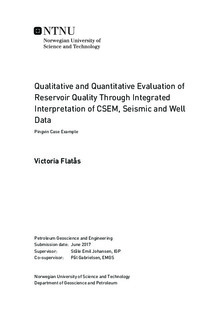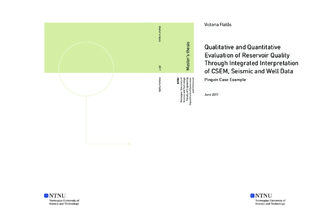| dc.description.abstract | In the last decades, the marine controlled source electromagnetic (CSEM) method has proven to be a useful tool for de-risking hydrocarbon prospects. Promising statistics and good data coverage in the Barents Sea have sparked the interest in using CSEM data for exploration purposes. The CSEM method has the advantage over conventional exploration techniques of being sensitive to hydrocarbon saturation and volume. The significance of integrating CSEM data with other geophysical data has been demonstrated in this thesis. Whether information in terms of reservoir quality can be obtained from CSEM data when incorporating seismic and petrophysical data, has been emphasized. Three-dimensional (3D) CSEM data together with two-dimensional (2D) seismic data and petrophysical data from exploration well 7319/12-1 have been used for qualitative and quantitative interpretation of the Pingvin gas discovery in the Bjørnøya Basin, Barents Sea. Quantitative interpretation entailed establishing relationships through petrophysical analysis between anomalous transverse resistance (ATR) and gross pay using models representing different reservoir qualities. These relationships have been combined with the ATR map created from constrained CSEM inversion results, to create gross pay maps from which reservoir quality has been interpreted.
The high-resistive CSEM anomaly obtained from constrained inversion corresponded with the seismic anomaly associated with the Pingvin discovery, both laterally and vertically. The resulting gross pay maps and the reservoir thickness interpreted from the seismic data have indicated improved reservoir quality towards the updip part of the seismic anomaly, relative to the part of the reservoir encountered by the well. Results have also shown that the gas saturation is likely to be higher in this same area compared to the saturation estimated from the well data. The results from this thesis highlight the importance of CSEM data for differentiating between brine and hydrocarbons as well as for qualitative and quantitative interpretation of reservoir quality. | |

